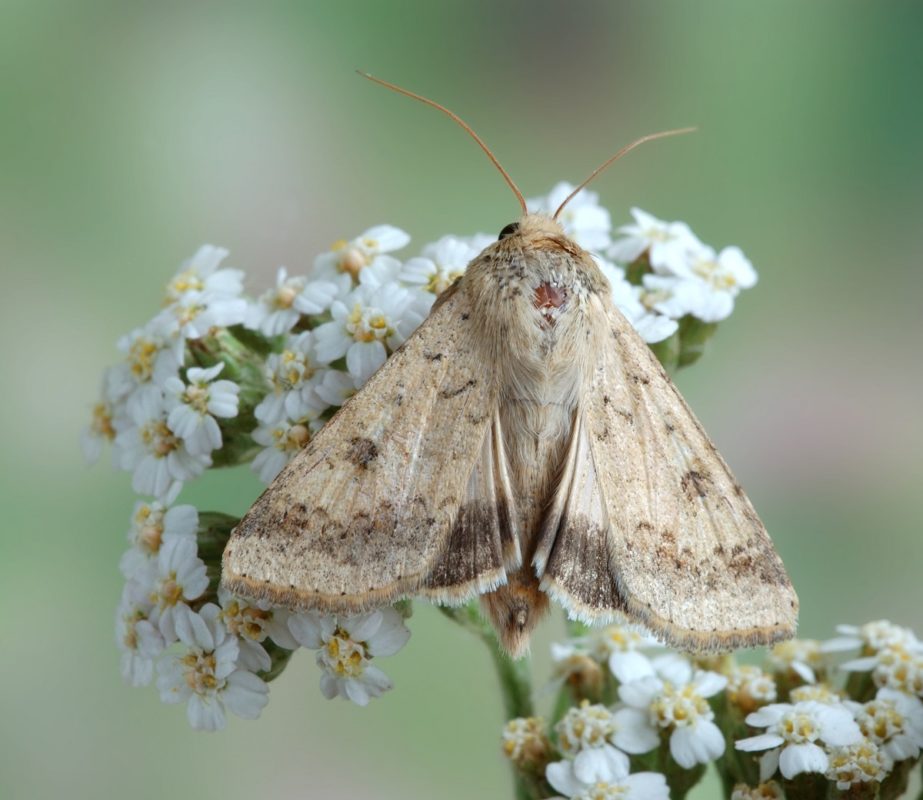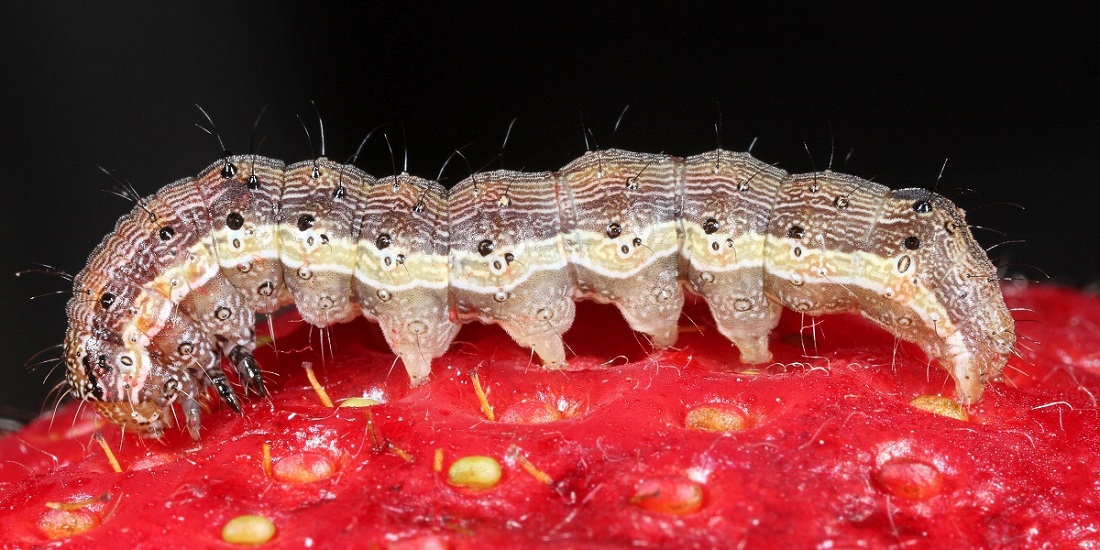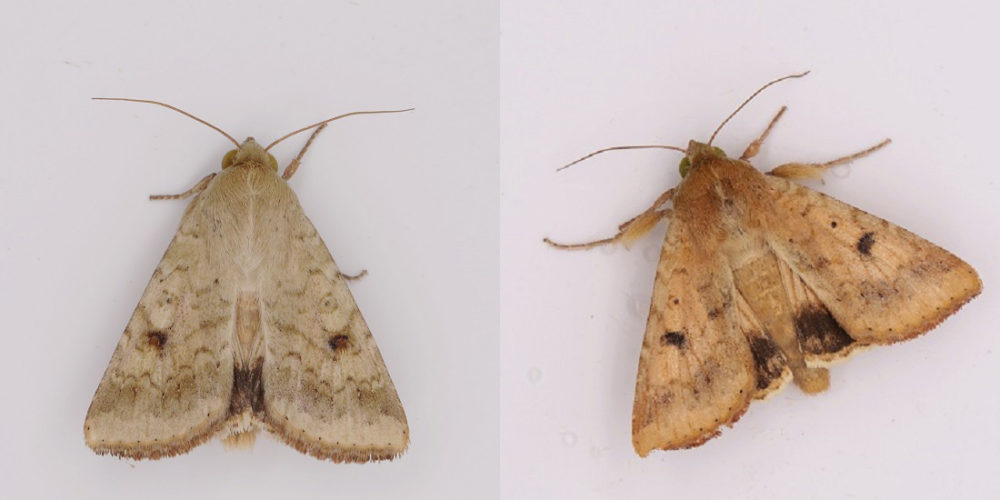Battling harmful insects by understanding their sense of smell
The larvae of cotton bollworm attack our food. But the adults pollinate plants. So how can we stop them from destroying crops without using poison? Researchers in Trondheim are on the case.
In NTNU’s Dragvoll laboratory in Trondheim, researchers keep different things in the closet than most of us do. Jars of moths stand in rows. The insects are actually pretty cute, but the Norwegian name for them suggests that they may be a little annoying: “Pest phage fly” is not exactly a name you give to a friend.

Heliothinae is a subfamily of moths and butterflies with several species that do great damage to crops. The cotton bollworm is among them. Photo: Shutterstock, NTB scanpix
The cotton bollworm’s Latin name is Helicoverpa armigera, and it belongs to a genus known to do great damage to crops. Two subspecies are about to divide the world between them, and only North America and of course Antarctica have been spared – for now.
But some people love this little guy.
An enthusiastic Bente Berg is a professor in NTNU’s Department of Psychology, and she notes that first and foremost, insects are useful.
She has been studying insects and their nervous system for decades and appears to be just as fascinated by them now as on day one.
- You might also like: The mystery of the blunt-tipped beetle penis
Larvae destroy, adults pollinate
The interactions between insects and flowering plants are well known, and they don’t just happen between flowers and bees. Lepidoptera is the order of insects that cotton bollworms belong to and includes thousands of different species of butterflies and moths that help plants reproduce.
The cotton bollworm feeds on everything from soybeans and tomatoes to rice and corn, and it doesn’t miss a chance to enjoy some tobacco either. But this feeding frenzy only applies to the larvae.
The adult moths are pollinators, says Berg – that is, insects that help pollinate flowers.
So how do we minimize the harm and maximize the benefit? According to the researcher, we need to learn more about how the insect brain works.

It’s not that big, but the larvae of the cotton bollworm can cause millions of euros of damage to plants. Photo: Steinar Brandslet
An alternative to poison
“We want to understand how the insect brain encodes odour information. By gaining a better understanding about how their brain functions, we may be able to use the insects’ own signals to control them,” says Berg.
This particular study is supported by the Research Council of Norway (NFR). The group at Dragvoll collaborates with teams in Beijing and Zhengzhou in China, where the moth poses a problem for the critical rice crops.
Given that moths can do so much damage, it is interesting to understand how they orient themselves in the world. By understanding how the moth finds its way to host plants, we might also be able to find ways to protect crops by influencing the moth’s behaviour.
Research has the possibility to contribute to reducing the use of poisons in agriculture, which are still applied in huge amounts. Even infamous DDT is still employed in large parts of the world.
But we have a long way to go before we can control insects. The current study is still basic research.
Ancient sense
“The sense of smell is the oldest sense we have. It’s ancient,” says Professor Berg.
Smell can be important for establishing memories. What smells makes you think of Christmas or Grandma or a place you played as a child?
The olfactory system is unique in relation to humans’ other sensory systems. For one thing, fragrance stimuli are small, volatile molecules, often produced by life itself.
“In contrast to visual and auditory stimuli, which can be plotted along an axis based on wavelength, olfactory stimuli are characterized by the fact that they are anatomically separated structures that can’t be arranged in any sensible form,” says Berg.
Secondly, smell has a more direct route into the parts of the brain that interpret our impressions than other senses. Smell impressions are largely processed in developmentally old regions of the brain.
- You might also like: Planting the seeds for a bioliterate tropical country
Own organ for CO2
Many insects also have an extra sense that humans lack. This organ may be similar to the sense of smell, but it only detects fluctuations in external CO2 levels.
“Their brains are so small, and yet so advanced,” says an impressed Berg.
This CO2 detector is called a “labial pit organ,” or LPO. Mosquitoes can also detect CO2 and use this organ to find us and other animals to feed on their blood, since we exhale CO2. But butterflies and moths do not engage in that kind of thing. They use their CO2 sensitive neurons to locate flowers that have just opened and contain nectar.

The illustration shows the location of the LPO, which is a separate organ that measures CO2 levels. Illustration: Cell Tissue and Research
Could this organ also play a significant role in helping female moths find suitable plants for laying their eggs?

The researchers have identified areas in the brain that exclusively interpret information from the LPO organ, and other areas that are involved in the treatment of plant odour signals and pheromones, respectively. Illustration: Frontiers in Physiology
Mapped nerve pathways in the brain
A recent article describes how the researchers at Dragvoll have mapped the pathway in the insect brain that carries nerve signals from the LPO into the brain.
“We did this by placing a dye into the LPO. We can observe the route this dye takes in the insect brain using a special microscope,” says first author Pramod KC, who performed the main part of the experimental work.
Doing this work requires knowledge, special equipment and some very special abilities. Nine people are affiliated with the chemosensory lab, and Berg boasts about all of them. Not just anyone comes to this lab. Students and researchers who are particularly interested and committed work here.
The researchers first remove the moth’s exoskeleton. This task isn’t for impatient people with trembling hands.
Removing the exoskeleton opens up a free path into the brain. Using the dye, the researchers can visualize various neural pathways, including those involved in transmitting signals from the LPO.
The researchers have identified areas in the brain that exclusively interpret information from the LPO, along with other areas involved in interpreting plant odour signals and pheromones.
Their research has attracted so much attention that the work has been published in Frontiers in Physiology, the world’s most cited physiology journal.
Important for insect survival
This study helps us understand a little more about how the insect brain functions and brings us a small step closer to finding alternative ways of handling insects to poisoning them.
The world probably has between six and ten million insect species. Harmful insects make up less than one per cent of all these species. However, herbicides kill many species, including important pollinators.
Insects play a significant role in all ecological systems on land. In a world where the number of insects is dropping dramatically, gaining more knowledge about alternatives to poison is important for the insects’ survival, and thus probably for our own as well.
Source: Frontiers in Physiology. Revisiting the Labial Pit Organ Pathway in the Noctuid Moth, Helicoverpa armigera. Pramod KC, Xi Chu, Pål Kvello, Xin-Cheng Zhao, Gui-Rong Wang and Bente Gunnveig Berg. Front. Physiol., 17 March 2020. https://doi.org/10.3389/fphys.2020.00202








